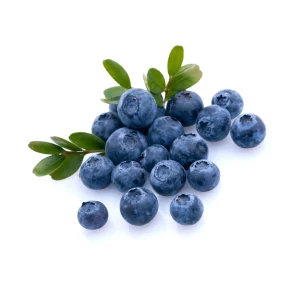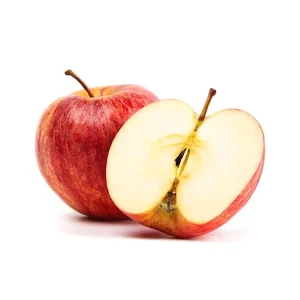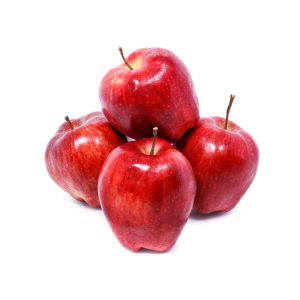In a world overflowing with health trends and superfoods, one berry stands out with a legacy as rich as its flavour: the blueberry. Often dubbed as \’superfoods,\’ these small, round delights are not just a summer treat; they are a treasure trove of health benefits waiting to be discovered. Packed with antioxidants, vitamins, and fibre, blueberries can be a game-changer for your health. But what exactly makes them so special? From enhancing brain function to promoting heart health, let’s explore the myriad benefits of blueberries and how they can contribute to a healthier lifestyle.
Nutritional Content
Blueberries are not only delicious but also incredibly nutritious. Here’s a breakdown of their nutritional content per one cup (about 100 grams) of raw blueberries:
| NUTRITION | CONTENT |
| Energy | 57 kcal |
| Protein | 0.74 g |
| Fats | 0.33 g |
| Carbohydrate | 14.5 g |
| Fibre | 2.4 g |
| Sugar | 9.96 g |
| Calcium | 6 mg |
| Iron | 0.28 mg |
| Magnesium | 6 mg |
| Phosphorus | 12 mg |
| Potassium | 77 mg |
| Zinc | 0.16 mg |
| Copper | 0.057 mg |
| Vitamin K | 19.3 µg |
| Vitamin C | 9.7 mg |
- Blueberries are also rich in antioxidant like anthocyanins ( pigment that gives blueberry its colour ) and phyto-components like flavonoids
Health Benefits of Blueberries
Anti-Inflammatory Properties
The anti-inflammatory effects of blueberries reduce the risk of various chronic diseases, including cardiovascular diseases and neuroinflammation. By reducing inflammatory biomarkers, they help in maintaining overall health and slow down the ageing process.
Rich in Antioxidants
Blueberries, especially wild varieties, are rich in antioxidants, surpassing cranberries, strawberries, and plums in antioxidant capacity. Antioxidants, particularly anthocyanins, help neutralise free radicals in the body. These antioxidants reduce oxidative stress, which is linked to various health conditions, including inflammation and chronic diseases.
Helps Regulate Blood Pressure
Wild blueberries may help regulate blood pressure and reduce the vulnerability of heart blood vessels to oxidative stress and inflammation. This makes them beneficial in managing hypertension, which is a major cause of kidney disease and heart problems.
Eye Health and Vision Protection
Blueberries contain anthocyanins that contribute to eye health by protecting the retina from oxidative damage and reducing inflammation. Studies show that anthocyanins can improve conditions like glaucoma, diabetic retinopathy, and myopia, enhancing visual accommodation and reducing eye fatigue.
Gut Health and Microbiota
Blueberries influence gut microbiota by promoting the growth of favourable bacteria that produce mucin, protecting the intestinal lining and reducing inflammation. In animal studies, blueberry intake modified gut bacteria, leading to improved gut health and better protection against harmful bacteria.
Protection Against High-Fat Diet Effects
Blueberries can mitigate the negative effects of a high-fat diet, particularly regarding insulin resistance, inflammation, and metabolic dysfunction. In studies, animals fed high-fat diets supplemented with blueberries showed better metabolic outcomes, including improved glucose tolerance and insulin response.
Cardiovascular Health
Anthocyanins in blueberries have vasoprotective effects that help maintain cardiovascular health. They support improved blood flow and reduce the risk of hypertension, promoting heart health and reducing the risk of cardiovascular diseases. They also benefit cardiovascular health by reducing oxidative stress and inflammation. They have positive effects on plasma lipid levels and glucose metabolism, which contribute to improved endothelial function.
Cognitive and Brain Function
Blueberries have been shown to improve cognition and brain function, especially in ageing populations. The anti-inflammatory and neuroprotective properties of anthocyanins help reduce the risk of dementia and neurodegenerative diseases by improving brain signaling and reducing oxidative stress in neural tissues.
Glucose Regulation
Blueberries help regulate blood glucose levels by improving insulin sensitivity. This makes them beneficial in managing blood sugar, reducing the risk of type 2 diabetes, and promoting overall metabolic health.
Cancer Prevention
Blueberries contain dietary fibre and phyto-components like flavonoids, which help in cancer prevention. Laboratory research shows that blueberries can decrease inflammation, DNA damage, and the growth of cancer cells, particularly in lung, breast, colon, and prostate cancers.
-
Fruit Baskets
An Apple A Day Basket (Assorted) – 4pc
₹212.00Original price was: ₹212.00.₹148.00Current price is: ₹148.00. -
Fruit Baskets
Valentine Special Basket (Assorted) – 9 pc
₹599.00Original price was: ₹599.00.₹499.00Current price is: ₹499.00. -
Berries and Grapes
Blueberry (Peru)
₹280.00Original price was: ₹280.00.₹224.00Current price is: ₹224.00. -
Exotic Fruits
Plum (China) – 6pc
₹120.00Original price was: ₹120.00.₹84.00Current price is: ₹84.00. -
Apples and Pears
Apple Royal Gala (Turkey) – 2pc
₹95.00Original price was: ₹95.00.₹67.00Current price is: ₹67.00. -
Apples and Pears
Apple Red Delicious (Turkey) – 2pc
₹117.00Original price was: ₹117.00.₹82.00Current price is: ₹82.00. -
Apples and Pears
Pear Green (South Africa) – 2pc
₹150.00Original price was: ₹150.00.₹130.00Current price is: ₹130.00. -
Exotic Fruits
Kiwi Green (Chile) – 3pc
₹152.00Original price was: ₹152.00.₹106.00Current price is: ₹106.00. -
Exotic Fruits
Avocado Hass (Tanzania) – 1pc
₹150.00Original price was: ₹150.00.₹105.00Current price is: ₹105.00.
Support for Healthy Aging
Blueberries contribute to healthy ageing by reducing oxidative stress, inflammation, and cognitive decline. The combination of antioxidants, anti-inflammatory effects, and glucose regulation helps promote overall health in later years.
Best Ways to Consume Blueberries
Fresh: Eating them raw is one of the best ways to enjoy their flavor and nutrients. Simply rinse and enjoy!
Smoothies: Blend blueberries with yogurt, spinach, or other fruits for a delicious and healthy smoothie.
Oatmeal or Cereal: Add fresh or frozen blueberries to your morning oatmeal or cereal for added flavour and nutrition.
Baking: Incorporate them into muffins, pancakes, or bread for a tasty treat.
Salads: Toss blueberries into salads for a sweet touch, pairing well with greens, nuts, and cheese.
Types of Blueberries
Blueberries come in various types, and each variety has distinct characteristics, including its country of origin. Here’s an overview of the main types of blueberries:
Highbush Blueberries
– Origin: Eastern United States
- These are the most common commercial blueberries, often seen in grocery stores. Highbush blueberries grow on tall bushes and are sweet and juicy. They thrive in moderate climates and are cultivated in the U.S., Canada, and parts of Europe.
Lowbush Blueberries
– Origin: Northeastern North America
- Also known as wild blueberries, lowbush varieties grow closer to the ground. They are smaller and have a more intense flavor compared to highbush blueberries. Lowbush blueberries are commonly found in the wild in Canada and Maine, USA.
Rabbiteye Blueberries
– Origin: Southeastern United States
- Named for the rabbit eye colour of immature fruit, these blueberries are larger and more heat-tolerant than other types. They are typically grown in the southern U.S. states such as Georgia, Florida, and Mississippi.
Southern Highbush Blueberries
– Origin: Hybrid varieties developed in the Southern U.S.
- These are hybrids of highbush and wild species, created to thrive in warmer climates. They are grown in the southern U.S., especially in Florida and California.
Northern Highbush Blueberries
– Origin: Eastern and Northern U.S.
- A type of highbush blueberry that is suited for cooler climates. They are commonly cultivated in northern states like Michigan and New Jersey, as well as Canada.
European Bilberry
– Origin: Europe and parts of Asia
- Similar to blueberries, bilberries are smaller and darker with a tart flavour. They grow in the wild in the colder regions of Europe, especially in Scandinavia, and are often used in jams and desserts.
Australian Blueberry
– Origin: Australia
- A species native to Australia, these blueberries are adapted to warmer and drier climates. While not as common globally, they are gaining popularity within Australia.
When to Avoid Blueberries
Risk of Blood Clots
Blueberries are rich in vitamin K, which affects blood clotting. If you take blood thinners, eating too many blueberries could increase clotting risks. Consult your doctor before making dietary changes.
Teeth Stains
Blueberries can stain your teeth due to their dark color. Brushing or rinsing after eating them can help prevent discoloration.
Salicylate Sensitivity
Some people may be sensitive to salicylates in blueberries, causing symptoms like nausea, rashes, or headaches. Severe reactions, like trouble breathing, need immediate attention.
Overconsumption
While they are an awesome source of many essential nutrients, consuming more than a cup at once may result in some gastrointestinal distress. It may also spike your blood sugar.
Myths and Facts about Blueberries
Myth: All Blueberries Are the Same
Fact: There are several varieties of blueberries, including highbush, lowbush, and rabbiteye, each with distinct flavours, sizes, and growing conditions. Highbush blueberries are the most common commercially, while lowbush blueberries are often found in wild settings and have a more intense flavour
Myth: Blueberries Can Only Be Eaten Fresh
Fact: While fresh blueberries are delicious, they can also be enjoyed in various forms, such as frozen, dried, or in jams and jellies. Freezing preserves their nutrients, making them a convenient option year-round.
Myth: Blueberries Are Only Good for You if You Eat Them Raw
Fact: Cooking blueberries can enhance their flavour and still retain many of their health benefits. They can be used in baked goods, smoothies, and sauces, and still provide essential nutrients and antioxidants.
Key Takeaways
Blueberries are a nutrient-dense superfood packed with antioxidants, vitamins, and fibre. A single cup contains 57 calories and essential nutrients like vitamin K and C. Their health benefits include anti-inflammatory properties, improved heart health, better brain function, and enhanced gut health. Blueberries can also aid in regulating blood pressure and glucose levels, potentially reducing the risk of chronic diseases, including cancer and type 2 diabetes. They come in various types, including highbush and lowbush, each with unique flavours and origins. Enjoy them fresh, in smoothies, or baked goods for maximum benefit. However, moderation is key, as excessive consumption can lead to digestive issues, and individuals on blood thinners should consult a doctor due to their vitamin K content.
-
Fruit Baskets
An Apple A Day Basket (Assorted) – 4pc
₹212.00Original price was: ₹212.00.₹148.00Current price is: ₹148.00. -
Fruit Baskets
Valentine Special Basket (Assorted) – 9 pc
₹599.00Original price was: ₹599.00.₹499.00Current price is: ₹499.00. -
Berries and Grapes
Blueberry (Peru)
₹280.00Original price was: ₹280.00.₹224.00Current price is: ₹224.00. -
Exotic Fruits
Plum (China) – 6pc
₹120.00Original price was: ₹120.00.₹84.00Current price is: ₹84.00. -
Apples and Pears
Apple Royal Gala (Turkey) – 2pc
₹95.00Original price was: ₹95.00.₹67.00Current price is: ₹67.00. -
Apples and Pears
Apple Red Delicious (Turkey) – 2pc
₹117.00Original price was: ₹117.00.₹82.00Current price is: ₹82.00. -
Apples and Pears
Pear Green (South Africa) – 2pc
₹150.00Original price was: ₹150.00.₹130.00Current price is: ₹130.00. -
Exotic Fruits
Kiwi Green (Chile) – 3pc
₹152.00Original price was: ₹152.00.₹106.00Current price is: ₹106.00. -
Exotic Fruits
Avocado Hass (Tanzania) – 1pc
₹150.00Original price was: ₹150.00.₹105.00Current price is: ₹105.00.











